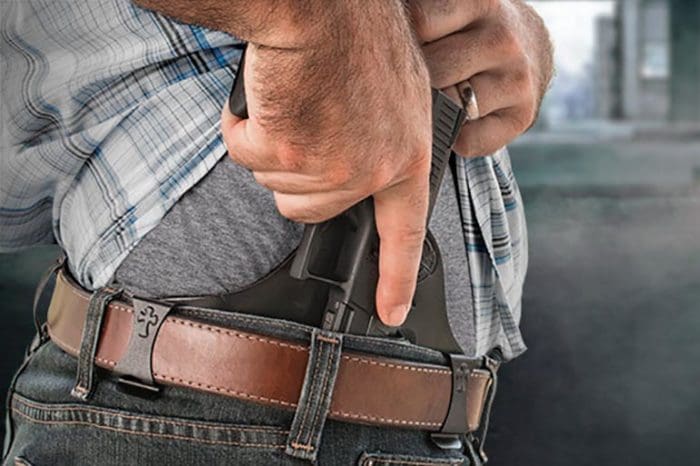By Johannes Paulsen
I read about too many negligent discharges involving re-holstering a handgun without sufficient brain engagement. Too many gun owners seem to take the process for granted or rush it and don’t pay attention to what they’re doing. That can lead to embarrassment, pain or worse. Don’t let this happen to you.
To some, holstering their gun looks cool. It shows the mastery of man over machine. But while style points are important in some endeavors, this isn’t one of them.
The main reason for many of these negligent discharges is, of course, a Rule 3 violation; finger on the trigger when sights aren’t on target. A secondary cause is a piece of clothing or equipment insinuating itself into the trigger guard, causing the pistol to discharge…frequently into your leg. Here’s one such instance that comes to mind.
Either way, an aggravating factor is a lack of attention paid to the process of securing the handgun.
While some trainers emphasize holstering while keeping your situational awareness up, consider this: the pistol should only be put away when the fight is truly over. Not when your opponent is down, but when he’s incapacitated, handcuffed or otherwise restrained or covered by others. Once that happens — once you are positively sure there is no longer a threat — then you can re-holster.
Caveat: if you are a civilian or off-duty cop, it’s never a good idea to have your blaster in your paws when the police arrive.
I’m not advocating spending 30 seconds to put your firearm properly into its rig. What I am saying, though, is…take the time to glance down, holster and prepare for the admin/legal issues that will follow in the aftermath of a defensive gun use.
In practical terms, whether it’s after a defensive gun use or just practicing at the range, taking the time to focus appropriately can spare you a lot of grief, and maybe some pain.
I have accumulated a little less than one hundred fifty hours of firearms training over the past few years, and many of the instructors I’ve worked with have thought that situational awareness is the paramount consideration. They take the approach that you should train to keep one’s head and eyes up at all time, continuing to scan for potential threats while re-holstering.
Only one I’ve encountered — Scott Reitz, of International Tactical — specifically advised that since re-holstering should only take place once the threat(s) is ended, glancing down to ensure re-holstering safely is always a good idea.
I’m an ordinary citizen who happens to carry a concealed firearm. That means my sidearm is either in an OWB holster under a jacket or shirt, or (for more formal occasions,) it’s in an IWB holster underneath a tucked shirt and suit jacket.
If it’s been drawn in a self-defense situation, when it comes to holstering, odds are good that my pistol will need to go back in underneath some rather askew, possibly even torn, clothing. Holstering when the gun is still hot, when the adrenaline is flowing, when the heart is pumping fast, when fine motor skills are at a low ebb, and when I may even be injured is probably not when I want to be securing my pistol without looking.
Lady Luck would doubtless be cruel enough to ensure that I would manage to prevail over some bloody-minded street thug, only to suffer a life-threatening wound from a negligent discharge because I wasn’t paying close enough attention while holstering afterward.
Practice doesn’t make perfect – it makes permanent. Whatever you do on the square range is probably what you’ll be doing when the balloon goes up. A glance downward to make sure you know what’s going on when you re-holster is a lot less risky than the alternative.
